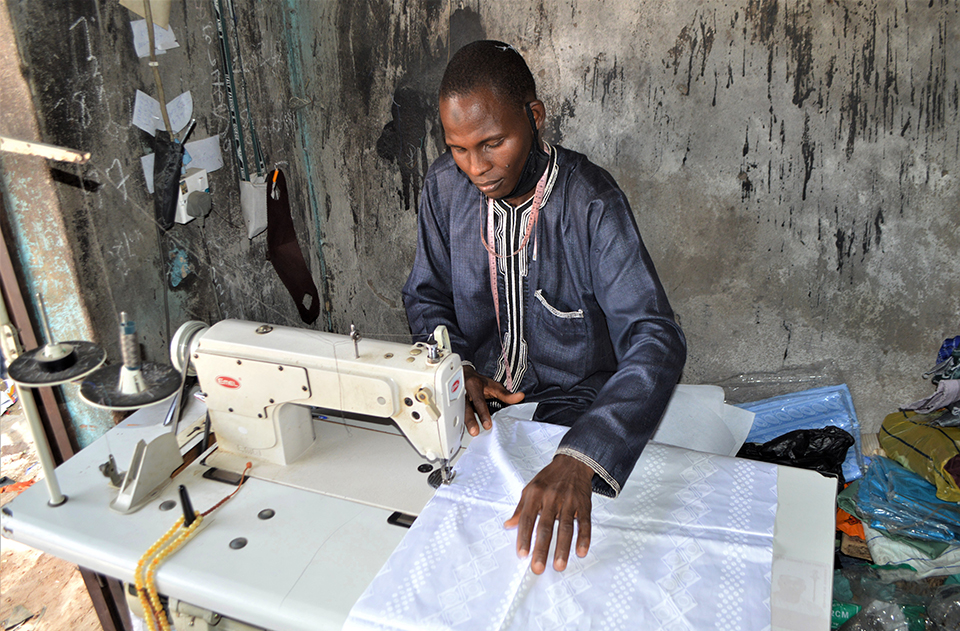

Savings Groups Spur Entrepreneurs in Nigeria
“SILC has helped me and the community. It has really helped in our savings.”
Mallam Sale Mahmuda started his tailoring business when he was 20 years old. When he realized he couldn’t afford to continue his education, he spent eight years learning to sew from a neighbor. Now 38 years old and a father of three, Mallam is an experienced fashion designer in his community of Libbo in Adamawa State, Nigeria.
In 2018 however, a fire at the workshop he shared with four other tailors destroyed Mallam’s most valuable business asset—an industrial sewing machine. Afterward, he could only afford a small sewing machine as a replacement. That significantly slowed his work and diminished his income. Two years before that, during a conflict between farmers and herders that led to nearby villages being burned down, the people of Libbo heard that their village might also be attacked. Mallam sold some of his properties and sent his wife and children to Gombe State for safety.
During these times, Mallam earned between $36 and $48 per month from his tailoring business and found it difficult to save. He says that attempts to secure loans from the only sources accessible to him—family and friends—were futile.
“They will first tell me to come today and then tell me to come tomorrow instead,” he said.
Without savings or a loan, Mallam was unable to fully recover from the fire.

Mallam’s income has seen about 60% increase following investments in his business.
Photo by Emmanuel Pius Dawa / JDPC Yola for CRS
In Nigeria, pervasive gaps in financial products geared toward small business owners limit the livelihood potentials of families and communities across the country. In 2020, PricewaterhouseCoopers estimated that there is a yearly financial gap of $1.5 billion for Nigerian micro, small and medium businesses. Entrepreneurs like Mallam who live in rural communities are even more disenfranchised.
The Savings and Internal Lending Communities, or SILC, methodology developed by Catholic Relief Services enables communities around the world to leverage their resources and mine savings and lending benefits through savings groups. In Mallam’s community and many others in Adamawa, Borno and Yobe states of Nigeria, CRS, is working with communities to establish savings groups so members can save and pool funds from which to borrow. The project is funded by Germany’s Federal Ministry for Economic Cooperation and Development through KfW Development Bank.
Mallam heard about the savings program in 2019 from a field agent in his community. He became so interested that he went about selling the idea to other community members so that they would have enough members to establish a group—typically around 15-30 people. In October 2019, the Hadin Kai savings group—Hadin Kai means “unity” in Hausa language—was launched with Mallam as a founding member. During the first savings cycle, which lasted for eight months, saving and lending took place and ended when accumulated savings and interest earnings were shared out to members. The group had 22 members and Mallam saved $6 every week.
More savings members
During this first cycle, Mallam took two loans. With one, he bought a small generator to work through power cuts. With the other, he bought materials to make and sell ready-to-wear clothing. Without frequent power interruptions, Mallam earned $54 in profits from the ready-to-wear clothing line. He paid off both loans within two months.
At the end of the first cycle in June 2020, Mallam had saved $142 with the group and received $155 during their share-out. That included earnings from the 20% service charge paid by members who were late with their loan repayments.
“Before SILC I’ve never gotten up to $121 that I can call my own in all the time that I have been doing business. But now, with SILC, I have gotten $167,” says Mallam. “Saving money for weeks before SILC was difficult because a need always comes up. The best I could do sometimes was to tie the money down in a goat or ram.”
Mallam invested his share-out in a new industrial sewing machine, which has shortened his turnaround time and number of completed sewing projects.
Now in its second cycle, Mallam’s savings group is at its maximum capacity of 30 people.
New opportunity
“More people have heard of the benefit of the group and are rushing to join,” says Mallam. He says that everyone in his group has benefitted. Three of his close friends and fellow group members who are in textile trading increased their capital bases by taking loans which they used to buy larger quantities of material. Selling these and repaying their loans gave them more profit over a short period of time. He says their lives have changed.
Mallam’s average monthly earnings from his tailoring business is now $68 and he is increasing his savings contribution.
“Now I know I have a financial target so I’m very careful with my expenses. I don’t want a situation where I come to a meeting and don’t have anything to give for saving.” In January 2021, Mallam accessed another loan under the second cycle which he invested in machinery for his business.
“SILC has helped me and the community. It has really helped in our savings,” he says. “We haven’t ever experienced this kind of opportunity that allows us to save and at the end of the day see the output. Thank you to the people who brought this to our community. I hope we can continue to enjoy it.”

